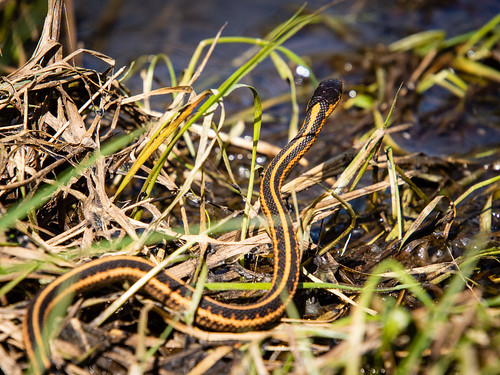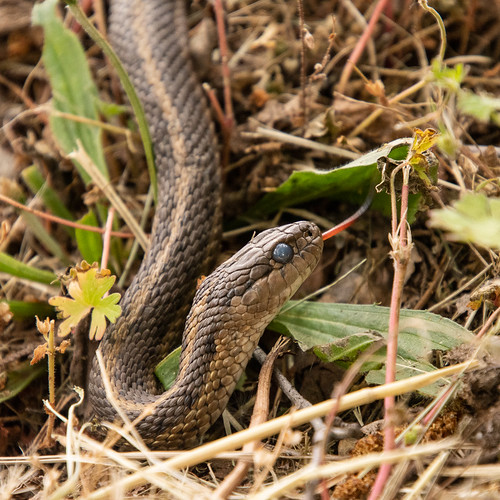So many people are terrified of snakes, and yet they are amazing creatures. We hope we can turn your fear into awe.
Snakes, with their flexible skulls and long bodies, are very different from lizards, their closest relatives. Scientists believe that the first snakes both swam like eels and burrowed like worms. The prehistoric South American Titanoboa was 50 feet long and may have weighed as much as a ton. It’s assumed that it preyed on equally huge crocodiles.
None of Saskatchewan’s snakes are anywhere near as large, but they are still a pretty interesting bunch.
Prairie Rattlesnake
Prairie Rattlesnakes are Saskatchewan’s only venomous snake. They immobilize their prey (rodents, lizards) with a toxic venom before swallowing them whole. Digesting their food makes rattlesnakes sluggish, so they normally hide out for a couple of days after eating.
Each time the rattlesnake sheds its skin, a ring is added at the end of its tail. The rings knock together and make a rattling noise.
The Prairie Rattlesnake carries her eggs inside her body and gives birth to live young as an adaptation to the harsh prairie environment.
Rattlesnakes have a thick body with a triangular head and are 1-8 feet long. The scales usually form a dark geometrical pattern on a light background. They are found in southern British Columbia, Alberta, and Saskatchewan; however, the majority live in the deserts of the American southwest and northern Mexico. Arizona has 13 species of rattlesnake, more than any other area in North America.
Garter Snake
Garter Snakes are long and thin and usually have 3 stripes on their back. Garter snakes can be found right across Canada, including the Northwest Territories, but there are none in Newfoundland. Plains Garter Snake live throughout southern Saskatchewan and are often found close to water where they can find frogs and toads to eat. Red-sided Garter Snakes are famous in Saskatchewan for their large mating balls. Wandering Garter Snake are technically terrestial, but they love to swim and eat fish.
Hognose Snake
Hognose Snakes are short (2-4 feet) and stout. Their colour and pattern are extremely variable. Western Hognose Snake will play possum and pretend they are dead as a way to deter predators. You’ll find them in sandy areas where it’s easier for them to dig in the dirt using their upturned, pointed snout.
Hognose Snakes eat rodents and lizards, although Eastern Hognose specialize in eating toads.
Bullsnake
The Bullsnake is the prairies’ biggest snake. It is 3-8 feet long and can weigh as much as 5 pounds. Despite being so large, they are very calm and are unlikely to bite or attack humans. Bullsnakes have a large head, large eyes, and a narrow neck. They are light brown to yellow with a cream-coloured belly and dark blotches on their back and sides. An enlarged nose shield helps them to burrow in the sand.
Bullsnakes squeeze their prey to death. They particularly like to eat gophers and mice, so you are lucky if you have them on your farm.
Bullsnakes spend up to 90% of their time in underground dens, although they spend so much time sunning themselves during the summer that they can develop skin cancer.
If you see a Bullsnake (dead or alive), especially in southwest Saskatchewan, email the Royal Saskatchewan Museum at snakes@royalsaskmuseum.ca to contribute to a current research project.
Smooth Greensnake
Smooth Green Snakes are a bright emerald green colour with a creamy white or yellowish belly. They are often found in grassy areas where their colouring provides excellent camouflage. Smooth green snakes mostly eat insects, which they detect through smell, sight, and vibrations. They spend their winters in ant hills.
Eastern Yellow-bellied Racer
Eastern Yellow-bellied Racers are long, smooth-scaled, and quick moving. They have a yellow belly and olive-coloured scales on their back. They live in mixed-grass prairie and sagebrush thickets where they can hide from predators. The species is threatened and very rare.
Eastern Yellow-bellied Racers don't bask in the sun like other snakes. They are always on the move, hunting for grasshoppers with their heads up.
Northern Red-bellied Snake
The Northern Red-bellied Snake is as thin as a pencil! Look for it in the Qu’Appelle area. It is the only Canadian snake with a bright red belly. Red-bellied snakes can be found in forest clearings and grassy areas where there is plenty of ground cover such as logs and rocks.
Red-bellied snakes are nocturnal and help to control garden pests, such as slugs, worms, snails, and insects.
Did You Know?
Snakes can swallow food larger than their head. Their jaw bones are not attached at the front and only loosely connected to their skull so they can open their mouths very wide and each side of the jaw can move independently. The snake gradually walks each side of its jaws over the prey until it can be swallowed.
Snakes taste and smell the world using their tongues. Thanks to their forked tongue, they can tell which direction the scent is coming from.
Large-bodied snakes such as Bullsnakes, Yellow-bellied Racers, and Rattlesnakes appear to be completely dependent on major river valleys. Find out more in this presentation by Ray Poulin, Royal Saskatchewan Museum.
Saskatchewan has the highest snake diversity in the Canadian Prairies.
Snakes play an important role in controlling rodent populations. They also serve as a food source for other wildlife, such as hawks, owls, mink, skunks, and herons.
What Can You Do?
Conserve native prairie habitat and river valleys. Like many species, snakes depend on native grasslands for their home.
Give snakes a break. Don’t kill or harass snakes. They are afraid of people and will only defend themselves.
Keep an eye out for snakes. Snakes will be crossing roads, especially in the spring and fall. Be particularly careful when you are driving in areas known to have snakes to avoid running them over.
Our thanks to the Saskatchewan Prairie Conservation Action Plan for assisting us in preparing this article. The Saskatchewan Prairie Conservation Action Plan (SK PCAP) Partnership brings together 30 agencies and organizations representing producers, industry, provincial & federal governments, environmental non-government organizations, research and educational institutions working towards a common vision of prairie and species at risk conservation in Saskatchewan. They produce a variety of communications materials to improve public understanding of native prairie and species at risk.
You can follow EcoFriendly Sask by liking us on Facebook, following us on Twitter, or by email (top right corner). A full list of upcoming events can be found on the EcoFriendly Sask Calendar
Nature Companion, a Comprehensive Nature App for Canada's Four Western Provinces
See Also



